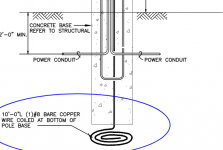The thing the NEC does not cover well with outside branch circuits and feeders is this situation ( similar to one that has recently been litigated) :
A 7500' plus foot lighting branch circuit (1+ mile bike/jogging path), everything is entirely non-metallic, PVC conduit, fiberglass lamp posts etc.
The EGC is insulated. The voltage is single phase 600V L-L (300V to ground).
Now near the end of the path a splice vault fills with water and a tap block has cracked and failed with exposed conductor to water.
There now is a L to ground connection 6500' wire feet from the 60A breaker feeding the circuit.
There are no ground fault relays or protectors just a regular 600V breaker.
Per NEC code there is no connection between the equipment grounding conductor and the earth other than at the service (a 7.2kV primary service
An additional 2500' away).
Is the voltage gradient around the vault dangerous to the public?
If there was a ground rod at the vault tied to the EGC what would it have accomplished


